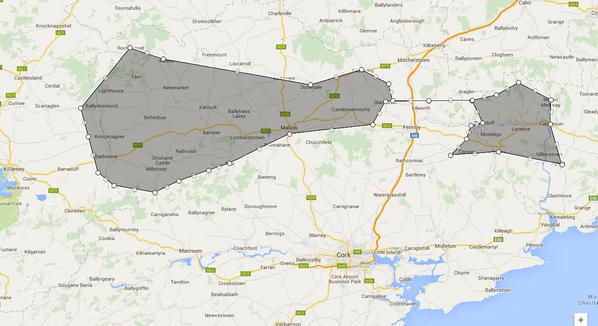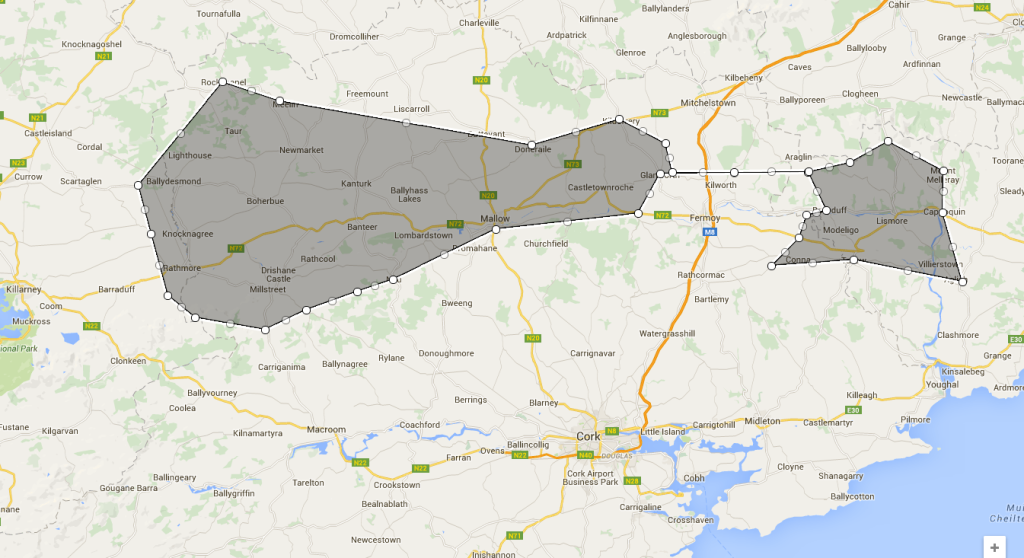
Today, I’d like I must write about the need for a proper Irish postcode system, and to outline the reasons why the €27m #Eircode project is being considered such a shambles and yet another missed opportunity.
The Post
Unless you’re in the transport industry in some shape or form, the only experience of postcodes you’re ever likely to have is with the postcode that Eircode assigns to your house. The natural assumption is to associate these postcodes solely with An Post delivering letters to your door. That assumption is wrong. Your Eircode will not help An Post for the foreseeable future. They’ve been delivering to your address, in some cases, since P&T was formed in 1922. They’re doing okay. It wasn’t perfect though. So An Post developed their own geolocation system in conjunction with the Ordnance Survey. (See for yourself at : www.geodirectory.ie.) For every BUILDING in Ireland the geodirectory provides “a unique, standardised address in the form of an eight-digit number, each pinpointed to an exact geographical location.” These services needed a unique standardised code – so they developed one. But that code is not Eircode. So, if An Post and the security, fire brigade, and ambulance services already had a working geocode, then why were they involved in developing a new one? I could speculate until the cows come home, but that’s what twitter is for. I’d prefer to focus on the reasons why those of us who actually could use these codes are so livid at Eircode’s poor design.
Online Shopping & Deliveries
I’ll assume that the vast majority of you would have no experience of actually processing postcodes in business. I’ll try to give you some insight into how they’re used in the transport industry globally. This happens from the tiniest courier place in London, to global giants like DHL or FedEx who have a 45 billion dollar annual turnover. (Yes, 45 billion. They’re so big, their aircraft can afford to pop wheelies.)
Let’s take online booking. You know those delivery charges which appear after you’ve bought your high-end triathlon gear from Chain Reaction or Wiggle? (Or your Fifty Shades of Grey from Amazon?) They’re calculated using postcodes. In the UK if you’re in BT28 (a Belfast postcode) and the goods are being shipped from a warehouse in WD8 (a Watford, UK postcode – go on you ‘orns!), the following can be figured out :
- A cost for delivery from a very small geographical area.
- An estimated date of delivery judging by that company’s usual service standards.
So far, so logical. This is an old system, but as you can see, its simplicity makes it extremely useful. Now, larger transport companies will have warehouses in all corners of the country – and those warehouses will be responsible for covering deliveries to particular postcodes. By assigning postcodes to particular warehouses, the entire country can be covered accurately, without conflict or overlap. Due to the lack of postcodes in the Republic of Ireland, many transport companies have their own internal version of postcodes. This was entirely necessary for most of us, as Irish county boundaries are problematic. (Cavan’s panhandle, for example, is best covered from Leitrim or Fermanagh, rather than Cavan county.) The problem remains that an internal sortcode is fine, but without the sort code being adopted by the entire country, its usefulness is limited. It doesn’t help with locating ambiguous addresses, etc.
Geographically Distinct Areas
The first few characters of a postcode are usually the sort key. The French postcode 75013 uses the first two digits as the sort code, with 75 being central Paris – the final 013 bringing you to the 13th district. (Incidentally the first two digits were being used by the French for their small administrative areas over 150 years ago. They understood its usefulness.) In the UK, the tiny area of HS1 gives you Stornoway, an island area in the Hebrides off the east coast of Scotland. This is the beauty of having a sensibly defined sort key. Anyone who has lived or travelled to an Irish or Scottish island knows that things work differently there. Deliveries may only be carried out twice a week. Ferries may only operate on certain days, at certain times, and may have strict weight restrictions, etc. Sometimes deliveries are only made as far as the port – with islanders organising the remainder of the trip. The cost and time it takes to deliver to an industrial estate outside Glasgow is often quite different to the cost and time of delivering to an island in the Hebrides. You may be a city dweller who wonders, who cares?! But without the postcode being of use to every address, there is no point in adopting it. We will only have to replace it when saner heads prevail at some point in the future – no doubt at considerable cost.
Without having a distinct SORT KEY for a geographically distinct area, a postcode is of no real benefit to any type of transport firm or agency. To take one example, Eircode have used the same sort key, F92, for Arranmore (Donegal’s largest inhabited island) and the north western Donegal mainland. Cill Rónáin, Inis Mór, the largest of the Aran Islands, has the same sort key H91, as Connemara and Galway City. Galway city and the Aran Islands may be in a relatively small geographical area, but keen eyes may have noticed that the Aran Islands are separated from the mainland by a small section of the Atlantic Ocean. Sort codes which ignore clear and obvious boundaries, like seas or oceans, need to be redesigned.
In two seconds a website could tell a Hebridean that his delivery will take 4 days at a cost of fifty quid by using the first three characters of the postcode. The Eircode-using Irish equivalent website would need to lookup a large database to tell an Arranmore resident the cost and time for delivery – and they’d need the full exact code. Any mistake made here, and your estimated delivery time, and cost for delivery will be wrong.
Unique Identifiers
Now, the pro-Eircode people, be they government departments, An Post (who won’t use it) or Nightline (the only one of approximately 3000 transport companies in the country who were consulted and the only one who claim they could use it), say that this new Eircode is unique to your address. Unique identifiers would be fine, but they’re of little use to anyone who hasn’t bought the latest version of the updated postcode database from Eircode. This is because the last four characters of the code are completely random – there is no geographical information contained in it. This means that in data terms it’s an expensive system. Rather than the code carrying the necessary information, with a simple grid system, you MUST carry out a data lookup to see what geographical location relates to the Eircode you’re trying to deliver to. Your code is useless without a fully up to date database which can provide the longitude and latitude co-ordinates. Think about it – when was the last time you updated your sat-nav? Even with the now 40+ year old UK postcode system, you could get within a few streets of any new house – regardless of whether you had all your devices up to date. (And regardless of whether you had a decent data or satellite reception.) Apart from one delivery company who have been given access to the entire database, the only non-governmental agencies who are promoting the Eircode as useful seem to be direct-marketing companies. Now whenever direct marketing companies are enthusiastic about anything, it’s time to pretend you’re not at home, or at the very least pretend you don’t speak English. (That reminds me of the snub Eircode have given the Gaeltacht areas and Irish addresses too, but I won’t deal with that here.)
In the UK, the postcode database used to be proprietary. They database was available at 4000 GBP per year, before they were advised to make it open source. The government were eventually convinced that making it available to businesses was of huge benefit to the economy and most significantly to small businesses. 4000 GBP was a fairly large fee for a small start-up to have to bear. They opened this up 2010. Five years later, Ireland is introducing a brand new closed system.
The problem of new buildings
When you build your new dream house out in the countryside, and you’ve been assigned your new postcode – people can start sending you mail and deliveries. Now because the only actual geographical information in the Eircode is the sort key, not all companies, or devices will have your eircode information. (In fact, at time of writing no sat-nav/GPS manufacturer, nor google maps plan to implement the Eircode system at all.) So, the best that you can hope for is that your delivery will arrive in your postal area, and you can direct them from there. Now you can see where it’s advantageous to have smaller geographical areas than “north west Donegal”, or the beautiful P51 eircode in which is actually split in two as shown below. In case you’re wondering, it would take 1 hr 40 minutes to drive across this Eircode which stretches from Cappoquin, Co Waterford all the way to Ballydesmond, Co Kerry. You’d also have to pass through two other postcodes on the way.

Alternative Postcodes
There have been alternative postcodes put forward. Both look promising. The most commonly suggested ones are http://www.myloc8ion.com/ and Openpostcode.org. I don’t know a whole lot about either one. What I do know from the papers, radio and Irish Government committee recordings which were uploaded to the web, is that the Loc8 Code was excluded from the tendering process by the government. Illegally so, according to the EU.
Both of these systems however are examples of postcodes that give valuable geographical information, without total dependence on satellite or internet look-ups.
Likely Outcomes
In the modern era, no politician or government agency is ever permitted to change their mind. We’re subject to the leadership qualities of the World War I Generals. You must proceed in a straight line towards the stated target. Even if 100,000 soldiers lie dead in no-man’s land before us, we must not waiver. In the modern era, to change your mind is seen as a fatal flaw – not as the result of consideration, reason and common sense. It ends, or at the very least, stunts careers. That’s why the Eircode disaster will probably be pushed through regardless of how awfully inadequate it is.
Some More Illuminating Reading (I might update this over time)
http://www.broadsheet.ie/2015/07/20/no-honour-no-code/
A Crowd Sourced Google Map of Eircodes
http://www.ossiansmyth.ie/eircode-routing-keys/


Comments
13 responses to “Irish Postcodes”
So I’ve tried to explain a few of #Eircode’s major flaws from a transport industry perspective. (We deliver stuff!) http://t.co/iGttBggujk
It’s refreshing to hear from someone who actually understands how it all works. So far we have only had transponsters telling transporters and Ministers telling medics how to do their jobs when it comes to postcodes!
Eircode has less functionality than Lat/Long which is hundreds of years old! I did an analysis for an Oireachtas Committee here http://www.loc8.ie/news.
Well done & thanks, Gary
RT @tigercooke: So I’ve tried to explain a few of #Eircode’s major flaws from a transport industry perspective. (We deliver stuff!) http://…
Irish Postcodes – http://t.co/xCeu8qPoxm <- Good read, from someone who understands the importance of geo locating an address
OT: I found this blog post to be a clear, easy-to-follow insight into #Eircode’s design shortcomings. http://t.co/8Px3j2GL65 @tigercooke
RT @PEdmondAero: OT: I found this blog post to be a clear, easy-to-follow insight into #Eircode’s design shortcomings. http://t.co/8Px3j2GL…
Read this guy’s blog post about why #Eircode is crap. http://t.co/ZPRKnyGEi3 from @tigercooke
RT @murphimarketing: Read this guy’s blog post about why #Eircode is crap. http://t.co/ZPRKnyGEi3 from @tigercooke
@highest_priest @fixtronix @Eircode @loc8code http://t.co/4UOhqrbC1g Refusal to get it suggests vested interest. #EirSockpuppet?
Irish Postcodes vs. #Eircode |
http://t.co/sjbSYHAKpJ http://t.co/LjfzAw1vAi
RT @OisinSF: Irish Postcodes vs. #Eircode |
http://t.co/sjbSYHAKpJ http://t.co/LjfzAw1vAi
RT @OisinSF: Irish Postcodes vs. #Eircode |
http://t.co/sjbSYHAKpJ http://t.co/LjfzAw1vAi
Incidental to your Scotland example, HS is quite a new invention. It replaced some PA postcodes in the mumble (90s?) This was because the mail boats left from Paisley at one point. But there was a distinction in the number part, so it was still not as bad as your Galway example.